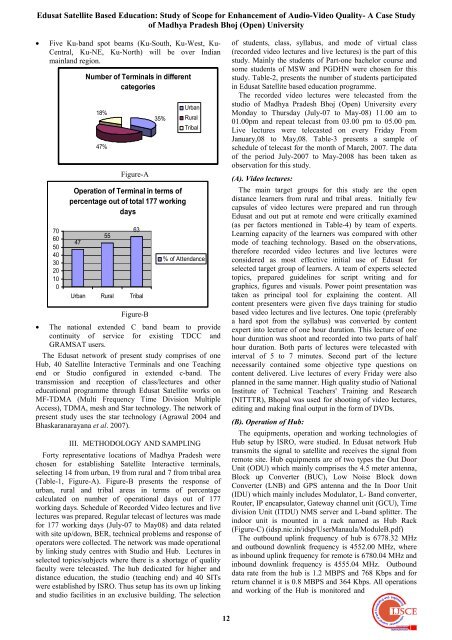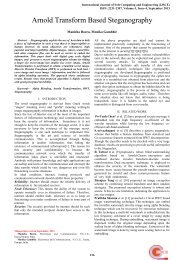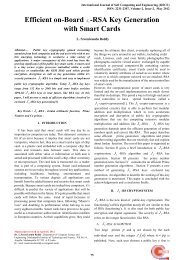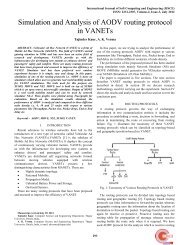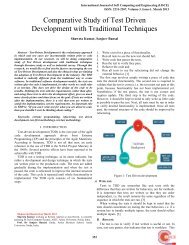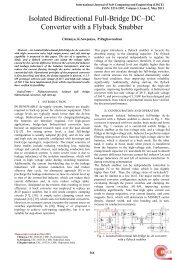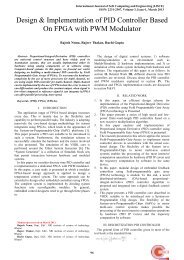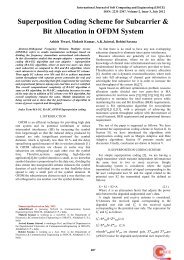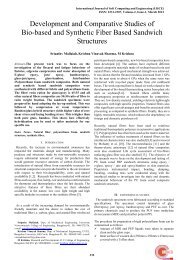Edusat Satellite Based Education - International Journal of Soft ...
Edusat Satellite Based Education - International Journal of Soft ...
Edusat Satellite Based Education - International Journal of Soft ...
Create successful ePaper yourself
Turn your PDF publications into a flip-book with our unique Google optimized e-Paper software.
<strong>Edusat</strong> <strong>Satellite</strong> <strong>Based</strong> <strong>Education</strong>: Study <strong>of</strong> Scope for Enhancement <strong>of</strong> Audio-Video Quality- A Case Study<strong>of</strong> Madhya Pradesh Bhoj (Open) University• Five Ku-band spot beams (Ku-South, Ku-West, Ku-Central, Ku-NE, Ku-North) will be over Indianmainland region.706050403020100Number <strong>of</strong> Terminals in differentcategories18%47%35%Operation <strong>of</strong> Terminal in terms <strong>of</strong>percentage out <strong>of</strong> total 177 workingdays4755Figure-A63Urban Rural TribalFigure-BUrbanRuralTribal% <strong>of</strong> Attendance• The national extended C band beam to providecontinuity <strong>of</strong> service for existing TDCC andGRAMSAT users.The <strong>Edusat</strong> network <strong>of</strong> present study comprises <strong>of</strong> oneHub, 40 <strong>Satellite</strong> Interactive Terminals and one Teachingend or Studio configured in extended c-band. Thetransmission and reception <strong>of</strong> class/lectures and othereducational programme through <strong>Edusat</strong> <strong>Satellite</strong> works onMF-TDMA (Multi Frequency Time Division MultipleAccess), TDMA, mesh and Star technology. The network <strong>of</strong>present study uses the star technology (Agrawal 2004 andBhaskaranarayana et al. 2007).III. METHODOLOGY AND SAMPLINGForty representative locations <strong>of</strong> Madhya Pradesh werechosen for establishing <strong>Satellite</strong> Interactive terminals,selecting 14 from urban, 19 from rural and 7 from tribal area(Table-1, Figure-A). Figure-B presents the response <strong>of</strong>urban, rural and tribal areas in terms <strong>of</strong> percentagecalculated on number <strong>of</strong> operational days out <strong>of</strong> 177working days. Schedule <strong>of</strong> Recorded Video lectures and livelectures was prepared. Regular telecast <strong>of</strong> lectures was madefor 177 working days (July-07 to May08) and data relatedwith site up/down, BER, technical problems and response <strong>of</strong>operators were collected. The network was made operationalby linking study centres with Studio and Hub. Lectures inselected topics/subjects where there is a shortage <strong>of</strong> qualityfaculty were telecasted. The hub dedicated for higher anddistance education, the studio (teaching end) and 40 SITswere established by ISRO. Thus setup has its own up linkingand studio facilities in an exclusive building. The selection<strong>of</strong> students, class, syllabus, and mode <strong>of</strong> virtual class(recorded video lectures and live lectures) is the part <strong>of</strong> thisstudy. Mainly the students <strong>of</strong> Part-one bachelor course andsome students <strong>of</strong> MSW and PGDHN were chosen for thisstudy. Table-2, presents the number <strong>of</strong> students participatedin <strong>Edusat</strong> <strong>Satellite</strong> based education programme.The recorded video lectures were telecasted from thestudio <strong>of</strong> Madhya Pradesh Bhoj (Open) University everyMonday to Thursday (July-07 to May-08) 11.00 am to01.00pm and repeat telecast from 03.00 pm to 05.00 pm.Live lectures were telecasted on every Friday FromJanuary,08 to May,08. Table-3 presents a sample <strong>of</strong>schedule <strong>of</strong> telecast for the month <strong>of</strong> March, 2007. The data<strong>of</strong> the period July-2007 to May-2008 has been taken asobservation for this study.(A). Video lectures:The main target groups for this study are the opendistance learners from rural and tribal areas. Initially fewcapsules <strong>of</strong> video lectures were prepared and run through<strong>Edusat</strong> and out put at remote end were critically examined(as per factors mentioned in Table-4) by team <strong>of</strong> experts.Learning capacity <strong>of</strong> the learners was compared with othermode <strong>of</strong> teaching technology. <strong>Based</strong> on the observations,therefore recorded video lectures and live lectures wereconsidered as most effective initial use <strong>of</strong> <strong>Edusat</strong> forselected target group <strong>of</strong> learners. A team <strong>of</strong> experts selectedtopics, prepared guidelines for script writing and forgraphics, figures and visuals. Power point presentation wastaken as principal tool for explaining the content. Allcontent presenters were given five days training for studiobased video lectures and live lectures. One topic (preferablya hard spot from the syllabus) was converted by contentexpert into lecture <strong>of</strong> one hour duration. This lecture <strong>of</strong> onehour duration was shoot and recorded into two parts <strong>of</strong> halfhour duration. Both parts <strong>of</strong> lectures were telecasted withinterval <strong>of</strong> 5 to 7 minutes. Second part <strong>of</strong> the lecturenecessarily contained some objective type questions oncontent delivered. Live lectures <strong>of</strong> every Friday were alsoplanned in the same manner. High quality studio <strong>of</strong> NationalInstitute <strong>of</strong> Technical Teachers' Training and Research(NITTTR), Bhopal was used for shooting <strong>of</strong> video lectures,editing and making final output in the form <strong>of</strong> DVDs.(B). Operation <strong>of</strong> Hub:The equipments, operation and working technologies <strong>of</strong>Hub setup by ISRO, were studied. In <strong>Edusat</strong> network Hubtransmits the signal to satellite and receives the signal fromremote site. Hub equipments are <strong>of</strong> two types the Out DoorUnit (ODU) which mainly comprises the 4.5 meter antenna,Block up Converter (BUC), Low Noise Block downConverter (LNB) and GPS antenna and the In Door Unit(IDU) which mainly includes Modulator, L- Band converter,Router, IP encapsulator, Gateway channel unit (GCU), Timedivision Unit (ITDU) NMS server and L-band splitter. Theindoor unit is mounted in a rack named as Hub Rack(Figure-C) (idsp.nic.in/idsp/UserManaula/ModuleB.pdf)The outbound uplink frequency <strong>of</strong> hub is 6778.32 MHzand outbound downlink frequency is 4552.00 MHz, whereas inbound uplink frequency for remote is 6780.04 MHz andinbound downlink frequency is 4555.04 MHz. Outbounddata rate from the hub is 1.2 MBPS and 768 Kbps and forreturn channel it is 0.8 MBPS and 364 Kbps. All operationsand working <strong>of</strong> the Hub is monitored and12


